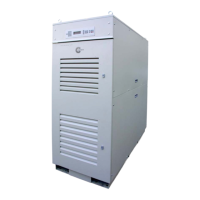Capstone Turbine Corporation
Model C65 Hybrid UPS User’s Manual
Page
30 of 66 400027 Rev A (July 2010)
Capstone reserves the right to change or modify, without notice, the design, specifications, and/or contents of this document without
incurring any obligation either with respect to equipment previously sold or in the process of construction.
Transfer from Utility Power to Hybrid UPS
Once a Hybrid UPS system is started and operating in either UPS Mode or High Efficiency
Mode, it is able to accept a block transfer of loads that were previously powered by the utility
source. Since there will be no inrush currents associated with motor starting or transformer
magnetization during a closed transition transfer, the Hybrid UPS systems will simply see a
step load change within their steady state power capability. This may result in a brief voltage
drop at the output of the Hybrid UPS system, however a properly designed installation should
maintain sufficient power quality to meet the requirements of the critical load.
System Shut-down
The Hybrid UPS system is designed for continuous operation, and will not be shut down in
normal operation. There are several means to shut the system down, depending on the
urgency of removing power from the critical loads.
Normal Shutdown
A normal shutdown would typically be done after the critical loads have been transferred
to the utility power source (as described above), or the loads themselves have been shut
down for service reasons. A normal shutdown process will transition the system from
either of its’ operating modes (UPS Mode or High Efficiency Mode), to the Standby Mode.
During this transition, power will be removed from the critical load and, if the turbine
generators are running, the system will make sure the external batteries are properly
charged before stopping the turbines using a cooldown. The power connection to the utility
will then be disconnected. While power will be quickly disconnected from the load, the
completion of a normal shutdown can take many minutes, depending on the state of
charge of the energy storage system. A normal shutdown can be initiated from the UPS
Controller in two ways.
• UPS Controller Touch Screen Display
– If the touch screen display panel is dark,
touch it anywhere to activate it. Enter the Maintenance screen using password,
and press the Local/Standby button. This will put all units into the Standby Mode.
• UPS Controller BMS Interface
– the UPS Controller is able to communicate with a
building management system or other external control equipment, and receive a
remote stop command. Refer to specific instructions provided by the building
management system integrator.
Fast Stop
A Fast Stop function is available through a discrete input to the UPS Controller. When
activated, the Fast Stop will immediately disconnect power to the load, and force any
running turbine generators into a cooldown without regard to battery state of charge. The
power connection to the utility will be disconnected as soon as the turbines have
completed their cooldown, leaving the system in the Standby Mode. Fast Stop is the
recommended system stop function for quickly removing load power, as it is not as
damaging to the turbines as the E-Stop function described below.
The Fast Stop discrete input can be wired to a building management system for automatic
operating in case of emergency, or can be wired to a manual “System Stop” button. Refer
to specific instructions provided by the building management system integrator or system
installer for the location of any System Stop button or instructions how to activate this
function from the building management system.

